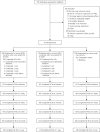Home-based, peer-led chronic illness self-management training: findings from a 1-year randomized controlled trial
- PMID: 19597169
- PMCID: PMC2713168
- DOI: 10.1370/afm.996
Home-based, peer-led chronic illness self-management training: findings from a 1-year randomized controlled trial
Abstract
Purpose: Studies suggest peer-led self-management training improves chronic illness outcomes by enhancing illness management self-efficacy. Limitations of most studies, however, include use of multiple outcome measures without predesignated primary outcomes and lack of randomized follow-up beyond 6 months. We conducted a 1-year randomized controlled trial of Homing in on Health (HIOH), a Chronic Disease Self-Management Program variant, addressing these limitations.
Methods: We randomized outpatients (N = 415) aged 40 years and older and who had 1 or more of 6 common chronic illnesses, plus functional impairment, to HIOH delivered in homes or by telephone for 6 weeks or to usual care. Primary outcomes were the Medical Outcomes Study 36-ltem short-form health survey's physical component (PCS-36) and mental component (MCS-36) summary scores. Secondary outcomes included the EuroQol EQ-5D and visual analog scale (EQ VAS), hospitalizations, and health care expenditures.
Results: Compared with usual care, HIOH delivered in the home led to significantly higher illness management self-efficacy at 6 weeks (effect size = 0.27; 95% CI, 0.10-0.43) and at 6 months (0.17; 95% CI, 0.01-0.33), but not at 1 year. In-home HIOH had no significant effects on PCS-36 or MCS-36 scores and led to improvement in only 1 secondary outcome, the EQ VAS (1-year effect size = 0.40; CI, 0.14-0.66). HIOH delivered by telephone had no significant effects on any outcomes.
Conclusions: Despite leading to improvements in self-efficacy comparable to those in other CDSMP studies, in-home HIOH had a limited sustained effect on only 1 secondary health status measure and no effect on utilization. These findings question the cost-effectiveness of peer-led illness self-management training from the health system perspective.
Figures
References
-
- Improving Chronic Illness Care, Robert Wood Johnson Foundation. The Chronic Care Model. http://www.improvingchroniccare.org/index.php?p=The_Chronic_Care_Model&s=2. Accessed Jun 21, 2008.
-
- Committee on Quality Health Care in America. Institute of Medicine. Crossing the Quality Chasm: A New Health System for the 21st Century. Washington, DC: National Academy Press; 2001.
-
- United Kingdom Department of Health. Saving lives, our healthier nation. http://www.archive.official-documents.co.uk/document/cm43/4386/4386.htm. Accessed Jun 21, 2008.
-
- Stanford Patient Education Research Center. Chronic Disease Self-Management Program. http://patienteducation.stanford.edu/programs/cdsmp.html. Accessed May 15, 2008.
-
- Lorig KR, Sobel DS, Stewart AL, et al. Evidence suggesting that a chronic disease self-management program can improve health status while reducing hospitalization: a randomized trial. Med Care. 1999;37(1):5–14. - PubMed
Publication types
MeSH terms
LinkOut - more resources
Full Text Sources
Medical

